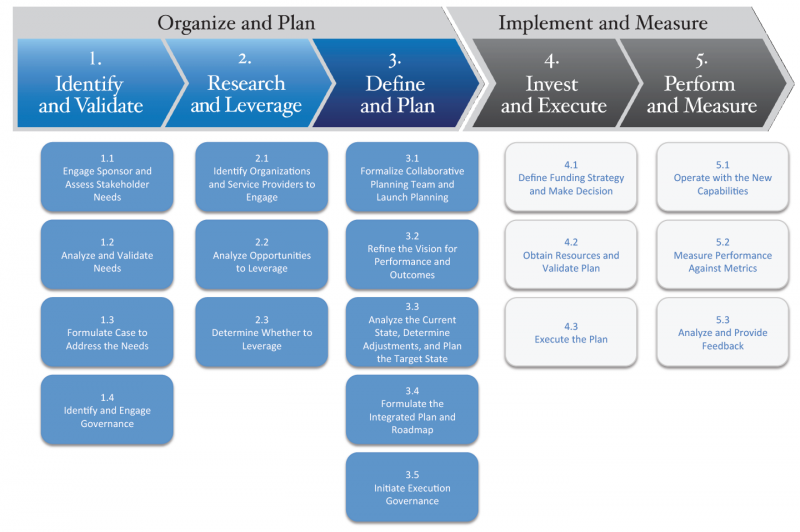
Overview of the Collaborative Planning Methodology
Planning is done to affect change in support of an organization’s Strategic Plan, and the many types of planners (e.g., architects, organization and program managers, strategic planners, capital planners, and other planners) must work together to develop an integrated, actionable plan to implement that change. Planning should be used to determine the exact changes that are needed to implement an organization’s Strategic Plan, enable consistent decision-making, and provide measurable benefits to the organization. In short, an organization’s Strategic Plan should be executed by well-rounded planning that results in purposeful projects with measurable benefits.
In today’s environment, which demands more efficient government through the reuse of solutions and services, organizations need actionable, consistent, and rigorous plans to implement Strategic Plans and solve priority needs. These integrated plans should support efforts to leverage other Federal, state, local, tribal, and international experiences and results as a means of reusing rather than inventing from scratch. Plans should be consistent and rigorous descriptions of the structure of the organization or enterprise, how IT resources will be efficiently used, and how the use of assets such as IT will ultimately achieve stated strategies and needs.
The role of planners is to help facilitate and support a common understanding of needs based on the organization’s Strategic Plan, help formulate recommendations to meet those needs, and facilitate the development of a plan of action that is grounded in an integrated view of not just technology planning, but the full spectrum of planning disciplines to include, but not limited to, mission/business, IT resources, capital, security, infrastructure, human capital, performance, and records planning.
Planners provide facilitation and integration to enable this collaborative planning discipline, and work with specialists and subject matter experts from these planning groups in order to formulate a plan of action that not only meets needs but is also implementable within financial, political, and organizational constraints. In addition, planners have an important role to play in the investment, implementation, and performance measurement activities and decisions that result from this integrated planning process.
The Collaborative Planning Methodology, shown below, is a simple, repeatable process that consists of integrated, multi-disciplinary analysis that results in recommendations formed in collaboration with sponsors, stakeholders, planners, and implementers. This methodology includes the master steps and detailed guidance for planners to use throughout the planning process. Architecture is but one planning discipline included in this methodology. Over time the methods and approaches of other planning disciplines will continue to be interwoven into this common methodology to provide a single, collaborative approach for organizations to use.
The Collaborative Planning Methodology is the next generation replacement for the Federal Segment Architecture Methodology (FSAM). As the replacement for the FSAM, the Collaborative Planning Methodology has been designed to be more flexible, more widely applicable, and more inclusive of the larger set of planning disciplines.
The Collaborative Planning Methodology is intended as a full planning and implementation lifecycle for use at all levels of scope defined in the Common Approach to Federal Enterprise Architecture: International, National, Federal, Sector, Agency, Segment, System, and Application.
The Collaborative Planning Methodology consists of two phases: (1) Organize and Plan and (2) Implement and Measure. Although the phases are shown as sequential, in fact there are frequent and important iterations within and between the phases. In the first phase, planners serve a key role facilitating the collaboration between sponsors and various stakeholders to clearly identify and prioritize needs, research other organizations facing similar needs, and formulate the plans to address the stated needs. In the second phase, planners shift into a participatory role, supporting other key personnel working to implement and monitor change related activities. As part of the second phase of the methodology, planners specifically support investment, procurement, implementation, and performance measurement actions and decisions.
The Collaborative Planning Methodology is stakeholder-centered with a focus on understanding and validating needs from sponsor and stakeholder perspectives, planning for those needs, and ensuring that what is planned ultimately results in the intended outcomes (Step 1). Additionally, this methodology is structured to embrace the principles of leverage and reuse by assisting planners in determining whether there are other organizations that have previously addressed similar needs, and whether their business model, experiences, and work products can be leveraged to expedite improvement (Step 2).
Ultimately, the Collaborative Planning Methodology helps planners work with sponsors and stakeholders to clearly articulate a roadmap that defines needs, what will be done to address those needs, when actions will be taken, how much it will cost, what benefits will be achieved, when those benefits will be achieved, and how those benefits will be measured (Step 3). The methodology also helps planners support sponsors and stakeholders as they make decisions regarding which courses of action are appropriate for the mission, including specific investment and implementation decisions (Step 4). Finally and perhaps most importantly, the methodology provides planners with guidance in their support of measuring the actual performance changes that have resulted from the recommendations, and in turn, using these results in future planning activities (Step 5).
The five steps of the Collaborative Planning Methodology are detailed in the following sections:
